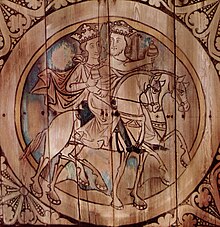Travel royalty
The Reisekönigtum was of the Frankish period up to the late Middle Ages, in the usual form of exercise of power by King or Kaiser (as travel king or travel Kaiser ). The German kings of the Middle Ages did not rule from one capital. They traveled with family and court through the empire from one palatinate to another. In other European countries, too, this was common in the absence of centralized rulership over longer periods of time, where it is known, for example, in English as itinerant kingship , traveling kingdom or in Italian as corte itinerante .
The old German Empire did not have a capital as it is today, but was ruled from different places. These places were mostly palaces built on crown property or bishops' cities . The journeys that the court took on these journeys are called itineraries . It should be taken into account that the Falzes were often laid out in easily accessible and fertile areas, which were surrounded to supply royal courts as the center of royal manors . The royal courts were scattered across the entire empire. The composition of the court changed, depending on the area through which one moved and which nobles joined the court with their entourage on this journey or also moved away from it again.
The travel speeds of the German royal court were usually 20 to 30 kilometers a day. With King Konrad III. was able to determine a peak value of up to 66 kilometers on his journey from Frankfurt to Weinheim in 1146.
The travel kingship served on the one hand to provide a better overview of the empire, but at the same time enabled control over local princes and thus served to keep the empire together. At that time, rulership was exercised over personal relationships ( person union state ), for which it was also necessary to seek personal contact with the ruled. On the other hand, it was only possible to meet the farm's economic needs by traveling, as at that time it was not yet possible to provide for a larger group of people permanently in the same place due to the inadequate transport routes. As a result, instead of sending the groceries to the farm, the farm went to the groceries.
literature
- Karl Otmar von Aretin : The Empire without a Capital? The multi-centrality of the capital functions in the empire until 1806. In: Theodor Schieder, Gerhard Brunn (Hrsg.): Capitals in European nation states. Oldenbourg, Munich et al. 1983, ISBN 3-486-51641-8 , pp. 5-13.
- Wilhelm Berges : The empire without a capital. In: The capital problem in history. Niemeyer, Tübingen 1952.
- Carlrichard Brühl : Fodrum, Gistum, Servitium Regis. Böhlau, Cologne / Graz 1968.
- Caspar Ehlers : place, region, empire. Mobility as a power factor. In: Gerhard Lubich (Ed.): Heinrich V. in his time. Rule in a European empire of the High Middle Ages (= research on the imperial and papal history of the Middle Ages. Volume 34). Böhlau, Cologne. et al. 2013, ISBN 3-412-21010-2 , pp. 81-102 ( online ).
- Edith Ennen : Function and meaning change of the 'capital' from the Middle Ages to the modern age. In: Theodor Schieder, Gerhard Brunn (Hrsg.): Capitals in European nation states. Oldenbourg, Munich et al. 1983, ISBN 3-486-51641-8 , pp. 153-164.
- Hans Conrad Peyer : The travel kingdom of the Middle Ages. In: Quarterly for social and economic history . 51, 1964, pp. 1-21 ( online ).
- Rudolf Schieffer : From place to place. Tasks and results of research into outpatient domination practice. In: Caspar Ehlers (Ed.): Places of rule. Medieval royal palaces. Vandenhoeck & Ruprecht, Göttingen 2002, ISBN 3-525-36261-7 , pp. 11-23.
- Andrea Stieldorf : Travel Authority and Residence in the Early and High Middle Ages. In: Historisches Jahrbuch 129, 2009, pp. 147–178.
Remarks
- ^ Carlrichard Brühl: Fodrum, gistum, servitium regis. Studies on the economic foundations of kingship in the Franconian Empire and in the Frankish successor states of Germany, France and Italy from the 6th to the middle of the 14th century. Vol. 1, Cologne et al. 1968 p. 163.
- ↑ Martina Reinke: The cruising speed of the German royal court in the 11th and 12th centuries north of the Alps. In: Blätter für deutsche Landesgeschichte 128, 1987, pp. 225-251, here p. 245 and p. 248 ( online ).
